- Rachel Morello-Frosch, Ph.D. - Partnering With Communities to Improve Water Quality and Access
- BJ Cummings – Improving Environmental and Community Health in the Pacific Northwest
- Weihsueh Chiu, Ph.D. – Using Data Science to Bridge Disciplines and Protect Health
- David Turcotte, Sc.D. – Academic-Community Partnerships Provide Tools to Address Environmental Health
- Beverly May, Dr.P.H. – Empowering Rural Communities in Central Appalachia
- Dwayne Porter, Ph.D. – Engaging Communities in Water Quality Data and Connection to Quality of Life
- Dana Haine – Mixing Research with Creativity to Appeal to Learners
- Laurel Schaider, Ph.D. – On the Frontlines of PFAS Research
Rachel Morello-Frosch, Ph.D. - Partnering With Communities to Improve Water Quality and Access
November 24, 2020
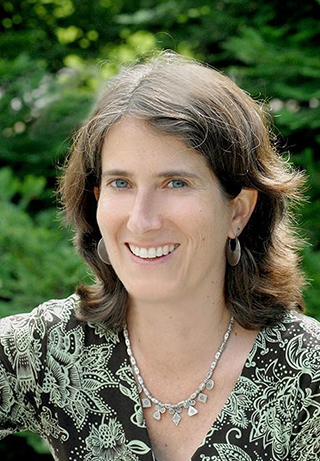
Morello-Frosch develops tools that translate research to stakeholders to improve public health.
(Photo courtesy of UC Berkeley)
Rachel Morello-Frosch, Ph.D., is an environmental health scientist at the University of California (UC), Berkeley. Her research focuses on how social factors, like race and poverty, and chemical exposures play a role in health disparities.
For over 20 years, much of her work focused on climate change, air pollution, and psychosocial stress. Currently, Morello-Frosch researches drinking water issues faced by California communities. She leads the Community Engagement Core - Water Equity Science Shop (CEC-WESS) of the UC Berkeley Superfund Research Program (SRP) Center.
Her interest in water quality stemmed from a prolonged drought in California from 2011 to 2017.
“The drought worsened some of the water quality and water access challenges faced by vulnerable communities, which are predominately communities of color and rural communities,” said Morello-Frosch. “There were increasing efforts to respond through new policies and important questions that needed to be answered. We felt that it was important to start doing that.”
As her research focus shifted, involving community members in the research process remained a common thread in Morello-Frosch’s work.
Combining Community and Data Driven Research
The need to respond to water quality and water access challenges was jointly identified by the UC Berkeley SRP Center CEC-WESS and the Community Water Center (CWC), an organization whose mission is to support community-driven water solutions in California.
In February 2020, the CWC and the UC Berkeley SRP Center CEC-WESS launched the Drinking Water Tool to provide California communities information about groundwater challenges that could affect their access to long-term safe and affordable drinking water. The interactive website features different data layers, such as water quality and groundwater supply measures, that can help communities and decision makers identify areas where water quality may be of concern across the state.
Morello-Frosch said the partnership with the CWC is mutually beneficial. The UC Berkeley SRP Center adapts project research priorities and tool development based on what the CWC learns from working in different California communities. The CWC has been instrumental in establishing authentic community connections.
“When you’re dealing with drinking water issues, it requires collaboration with partners that know what’s going on in the field and the diversity of issues facing these different communities,” she said. “From our vantage point at UC Berkeley, we would never have had that important level of expertise to guide our science to make sure we’re collecting the right data analyzing it and interpreting it in a way that makes sense for the community.”
Stronger Partnerships, Stronger Science
Another function of the tool developed by the research team has helped identify communities in California where households rely on private, unregulated groundwater wells for water. Until recently, this had been a huge data gap. Identifying these household well communities is important as many Californians rely on them as their source of drinking water. Contamination from sources such as airports, military sites, and landfills, and natural events like sustained droughts can affect these unregulated wells.
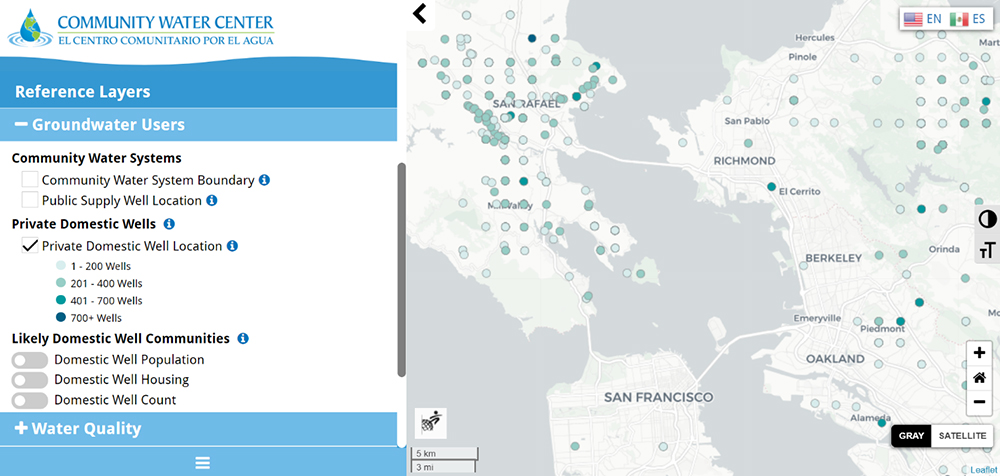
With this new information, researchers can identify ways to improve and refine private well monitoring efforts. Morello-Frosch said the ability to fill in data gaps like these are largely due to the work of the SRP-funded CEC-WESS.
“How the SRP is structured through center grants encourages collaborative research that otherwise would be very difficult to carry out,” said Morello-Frosch. “Being able to bring together community organizers, university scientists, and regulatory partners has ensured the comprehensive functionality of our work.”
Implications of Water Quality and Water Access Efforts
Community needs spurred the creation of the Drinking Water Tool, but now others are realizing its benefits. For example, local government entities have used the tool to conduct needs assessments and inform decision-making about where to invest resources to improve water quality and access.
The tool has also sparked meaningful conversations and encouraged the State Water Resources Control Board to accelerate its efforts. The board noticed the tool’s capabilities and is now looking add drinking water risk data to their own groundwater information tool.
“Putting a tool like this out there motivates and catalyzes regulatory agencies to realize what they could do and how they could build upon it,” said Morello-Frosch. “Our partnerships are critical to ensuring the rigor, relevance, and policy reach of the work that we do.”
Morello-Frosch continues to develop public health tools that translate research to stakeholders. For example, through support from another NIEHS-funded grant, she and colleagues are developing software that will allow researchers to generate high-quality, reports about a study participant’s level of exposure to environmental chemicals on smartphones. These reports help participants better understand what they are exposed, potential health concerns of exposure, and actions they can take to protect their health.
BJ Cummings – Improving Environmental and Community Health in the Pacific Northwest
November 9, 2020
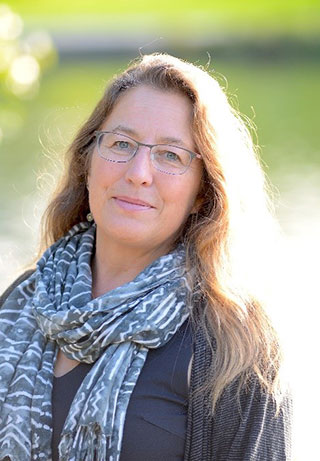
BJ Cummings is the manager of the Community Engagement Core of the University of Washington Superfund Research Center and Center for Exposures, Disease, Genomics, and Environment.
(Photo courtesy of Steve Shay)
BJ Cummings has a long history of building relationships to forge a new understanding and appreciation of community-focused environmental health. In her role as manager of the Community Engagement Core of the University of Washington Superfund Research Program (UW SRP) Center and the University of Washington Center for Exposures, Diseases, Genomics, and Environment (UW EDGE) Center, she facilitates collaborations between environmental health researchers and communities.
Like the lower Duwamish River, a five-mile waterway in south Seattle that empties into Puget Sound, Cummings’ career has flowed down a steady course: advocacy for healthy communities in the Duwamish River Valley. She has spent more than 20 years working in different roles within environmental justice. Among her accomplishments, Cummings recently published a book, "The River That Made Seattle" an environmental and social history of the Duwamish River.
“Growing up I had a passion for biology, the environment, and science,” said Cummings, who earned a master’s degree in environmental geography. “But I was raised by a labor organizer and a social worker. They inspired me to bring their lens of the world into my work in environmental science. This led me to environmental health and justice.”
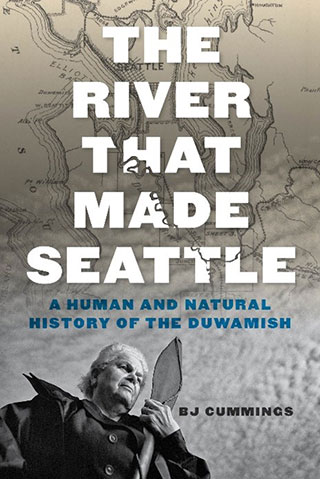
Bridging the natural and human environments has been a central tenet of Cummings’ career. Prior to joining the UW SRP and EDGE Centers, she founded the nonprofit organization Duwamish River Cleanup Coalition, coauthored several community health studies including a Cumulative Health Impacts Analysis, and served as the Puget Soundkeeper Alliance's “Soundkeeper.” Her work has inspired, empowered, and educated people living in the greater Seattle metropolitan area about their rich water resources.
A Legacy of Pollution
Since arriving to the area in 1851, settlers foresaw the utility of the Duwamish River as a springboard to industrial and commercial development. Activities such as shipping manufacturing, metal fabrication, and food processing led to contamination and dredging of the river. Population growth and industry displaced Native American communities, whose livelihoods relied on the river ecosystem, including fishing for salmon and cod, harvesting clams, and gathering plants.
It was not until the ecological movement in the 1970s and community organizing in the 1990s by leaders like Cummings that the Duwamish River was declared a Superfund Site by the U.S. Environmental Protection Agency (EPA) in 2001. According to Cummings, the Duwamish is one of the most toxic waste sites in the U.S.
“In Seattle, we consider ourselves to be a very progressive and ecologically-minded city,” said Cummings. “But because the Duwamish River is in the industrial district, many do not even know it exists. We certainly do not know its history, nor how central it was in creating the city we have today. I wanted to introduce the people of Seattle to their hometown river because you are not going to care about something if you do not know anything about it.”
A legacy of industrial pollution of the Duwamish River has exposed Seattle’s racially and economically diverse population to harmful chemicals and heavy metals, some of which have been linked to cancer. Among the most dangerous to human health are polychlorinated biphenyls, polycyclic aromatic hydrocarbons, arsenic, and dioxins. According to Cummings, these contaminants build up in the riverbed and bioaccumulate in the food chain, eventually reaching humans through seafood consumption.
Reducing Community Exposures
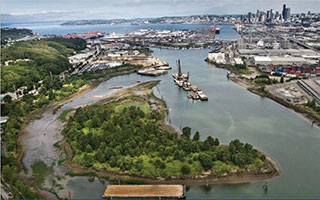
The Duwamish River, once stretched 12-miles long, has been straightened and shortened to a five-mile canal.
(Photo courtesy of Tom Reese)
Researchers at the UW SRP Center study how exposure to heavy metals, like those found in the Duwamish River, affect human and ecological health. Specifically, they examine how metal exposure may harm the human nervous system and affect the health of salmon, which spend part of the lives in the river.
“One of the joys of my job is helping the university and its researchers develop relationships with those communities who are living in and impacted by the research topics they are studying,” said Cummings. “Our goal is to not only communicate the relevance of the university research, but also to better understand the environmental health issues affecting the local community and tailor our research to their needs.”
One issue affecting the local community is effective communication about safe fishing in the Duwamish River. Despite being one of the most polluted rivers in the nation, it remains a popular fishing spot, especially among Native people, immigrants, and low-income residents. To address this need, the UW SRP Community Engagement Core partnered with Public Health — Seattle and King County, the Washington Department of Fish and Wildlife, local nonprofit organizations, and EPA Region 10 to develop nine videos in four languages. The videos advise fishers to catch only salmon, which spend only a short time in the river, and likely contain lower levels of harmful chemicals than fish that spend their entire lives there.
The UW SRP Community Engagement Core also partners with the Northwest Toxic Communities Coalition to help community-based organizations lead hazardous waste cleanups. The Coalition delivers informational webinars that are shared among NIEHS SRP Centers across the U.S. Looking forward, Cummings hopes to develop a new model of collaboration between academia and communities, one that is committed to equity and values the river and its people.
Public Engagement for Cutting Edge Science
Cummings also co-leads the Community Engagement Core within the NIEHS-funded UW EDGE Center. The Community Engagement Core disseminates Center research on complex topics such as epigenetics, metabolomics, and nanotoxicology to the community. The Core also builds the capacity of Center researchers to improve their public engagement and outreach skills.
Cummings’ recent work has brought UW EDGE researchers, local community groups, and other stakeholders together to address the health impacts of air pollution. For example, the UW EDGE Center co-hosted a community discussion on air quality in a Seattle neighborhood. The event featured community residents, the Duwamish River Cleanup Coalition, and UW EDGE researchers. After listening to personal stories from community members about how poor air quality affects their lives, Joel Kaufman, Ph.D., UW EDGE Center Director, and Edmund Seto, Ph.D., Center member, discussed their air pollution research and fielded questions from community members.
Cummings is also examining how environmental health and socioeconomic factors might influence COVID-19 risk and testing rates in King County, Washington. This work was prompted by community concerns about how the high levels of air pollution in the area may affect COVID-19 outcomes. Cummings worked with UW EDGE Center researchers who created an online mapping tool that integrates data on health, socioeconomic, and environmental factors. The research showed that King County communities that are poorer and have higher levels of air pollution also tend to have higher rates of COVID-19 cases. These communities also had lower COVID-19 testing rates. The disparity prompted Public Health - Seattle and King County to increase the number of testing centers in these communities.
Related Links
- Learn more about Cummings’ work to educate people about the Duwamish River in an August 2020 Environmental Factor article.
- Read more about the fish consumption videos developed by the UW SRP Center and partners in an SRP News Story.
Weihsueh Chiu, Ph.D. – Using Data Science to Bridge Disciplines and Protect Health
September 14, 2020
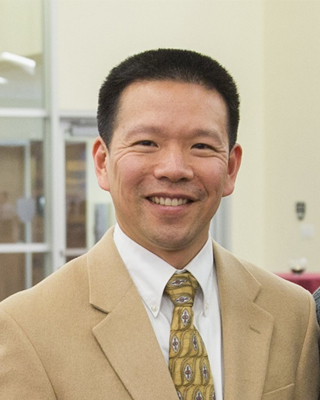
Chiu is a professor in the Department of Veterinary Integrative Biosciences in the College of Veterinary Medicine and Biomedical Sciences at TAMU. He is also a co-investigator for the TAMU SRP Center Training Core and Research Translation Core.
(Photo courtesy of TAMU)
Weihsueh Chiu, Ph.D., uses data science to create tools to help decision makers and communities better protect health. As the Decision Science Core leader within the NIEHS-funded Texas A&M University Superfund Research Program Center (TAMU SRP Center) and the Data Science Facility Core leader for the NIEHS-funded TAMU Center for Environmental Health Research (TiCER), Chiu integrates data from different disciplines, from toxicology to environmental science and social science, to address pressing environmental health problems.
After earning his Ph.D. in physics and a certificate in environmental policy from Princeton University, Chiu spent much of his career working at the U.S. Environmental Protection Agency (EPA). As chief of the EPA Toxicity Pathways Branch, he used statistical and data science approaches to better understand how exposure to toxic chemicals affect human health. His research focused on modeling how hazardous substances enter the body, how they move and change in the body, and at what exposure levels they can cause harm. He also focused on characterizing the level of variability in biological responses to toxicants and the level of uncertainty in risk assessments using advanced mathematical approaches.
Now, Chiu is leveraging data science approaches to develop user-friendly tools that address critical needs in the face of environmental and public health disasters.
“A major challenge in addressing complex environmental health problems is integrating large quantities of different types of data that come from different sources with different levels of quality,” said Chiu. “I’m interested in using a solid scientific framework for integrating data while making it accessible and understandable so it can be used to better characterize environmental justice issues, health disparities, and other health risks.”
Helping Vulnerable Communities Tackle Complex Problems
Chiu was asked to help after Hurricane Harvey hit Houston in 2017, where many historically disadvantaged communities faced catastrophic flooding and the spread of hazardous contaminants into their communities. The storm’s aftermath highlighted the need for better tools to help communities and decision makers identify and prioritize particularly vulnerable areas.
Researchers at the Environmental Defense Fund, who were working in the area following the hurricane, reached out to Chiu and his team for help integrating data that could be used to inform community actions. Leveraging an existing collaboration with colleagues at North Carolina State University (NCSU), the team developed the HGBEnviroScreen tool. HGB stands for Houston-Galveston-Brazoria in the Gulf Coast. The tool compiles diverse data from over 1,000 census areas in the HGB region, including information related to social vulnerability, baseline health, environmental exposures and risks, pollution sources, and flooding.
“The community played a key role in identifying the data they wanted to include and what data sources were important to them,” Chiu noted. “For example, they were particularly interested in flooding and food deserts within the community.”
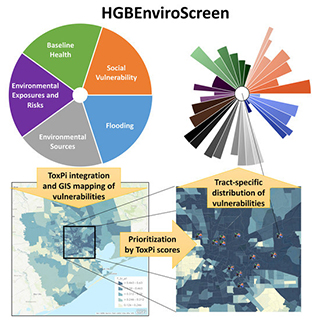
HBGEnviroScreen integrates data on factors like flooding, environmental exposures and social vulnerability into a map. Pie charts in each county show which factors contribute most heavily to vulnerability to disasters, indicated by the size of each pie slice.
(Photo courtesy of Bhandari et al., 2020, Int J Environ Res Public Health)
HBGEnviroScreen builds on the Toxicological Prioritization Index, or ToxPi, developed by David Reif, Ph.D., and colleagues at NCSU. This approach allows users to integrate multiple sources of data and visualize results as pie charts. The result is an interactive map showing how different communities’ vulnerability breaks down into different categories. Community groups may use the tool to better understand how environmental and socioeconomic factors can combine to increase susceptibility to health problems or vulnerability to disasters.
“This tool provides critical information that can help residents request better services from municipalities and work with local businesses to reduce exposures,” Chiu said. “One of the outcomes of this work is that the community was able to identify air pollution as an important factor and the need for air monitoring in specific areas.”
Adapting to New Emergencies: COVID-19
As Coronavirus Disease 2019 (COVID-19) began to spread across the U.S., Chiu and his research partners quickly leveraged their expertise in data integration to develop a new tool to explore how COVID-19 spreads and which communities may be at a higher risk of infection.
The team, including Chiu; Reif; Alison Motsinger-Reif, Ph.D., chief of the NIEHS Biostatistics and Computational Biology Branch; and others created the COVID-19 Pandemic Vulnerability Index (PVI) Dashboard to communicate COVID-19 data and identify areas that are likely to be affected by the disease.
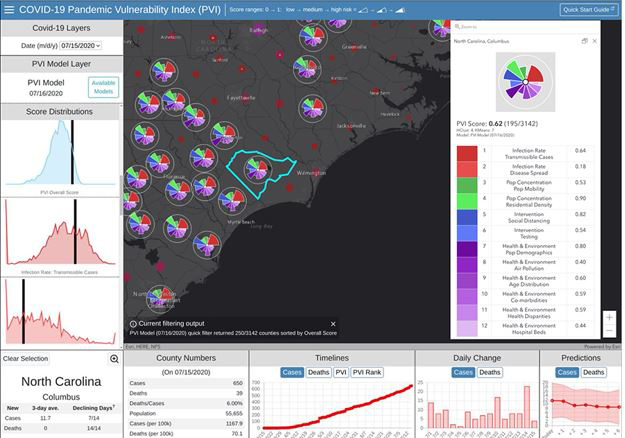
“The COVID-19 pandemic has shed light on the fact that people who are already vulnerable, such as those facing environmental justice concerns, are disproportionately affected by the disease,” Chiu noted. “Our team is really committed to making sure that the approaches we use don’t perpetuate biases, such as in how the data are collected, or limit access for those who need it most.”
COVID-19 PVI is a web-based, GIS-enabled tool that integrates data on COVID-19 infection rates, population concentration, current interventions, healthcare resources, air quality, and more. The goal is to help decision makers visualize potential infection hot spots and prioritize resources. It also provides data to address vulnerable populations and to inform decisions about enhancing or relaxing intervention measures, such as social distancing, testing, and mask wearing.
“The main limitation of most of the online maps currently available is that they are looking in the rear-view mirror, especially due to the long incubation period of COVID-19,” said Chiu. “The vulnerability index aims to look forward and identify potential future hot spots to help decision-makers initiate, intensify, or relax interventions based on the data.”
Promoting Transdisciplinary Approaches and Training the Next Generation
“Environmental public health issues are incredibly complex and it can be challenging to disentangle all the different pieces that are connected and influence each other,” Chiu noted. “SRP’s approach to bridging diverse disciplines and encouraging partnerships at the community level is really unique and useful to address these complex problems and come up with practical solutions.”
Chiu attributes the collaborative and transdisciplinary focus within SRP with opening up new areas of interest in his research. Building on these new directions, he and his collaborators within SRP were able to obtain additional funding from EPA to build community resiliency in the aftermath of natural disasters. According to Chiu, this important work would not have been possible without the foundation SRP provided.
In addition to his research activities, Chiu is involved in the NIEHS-funded training program at TAMU, focused on regulatory science in environmental health and toxicology. Through this program, Chiu and colleagues prepare the next generation to be independent, multidisciplinary researchers who are well equipped to tackle emerging environmental health problems and inform decision making to protect health.
“Our trainees benefit from different perspectives not only across disciplines, but also from collaborations and partnerships outside of academia,” he said. “Opportunities to get outside of the lab and work with communities and other partners is unique and important to equip the next generation with diverse skills to make a difference in the world.”
David Turcotte, Sc.D. – Academic-Community Partnerships Provide Tools to Address Environmental Health
June 16, 2020
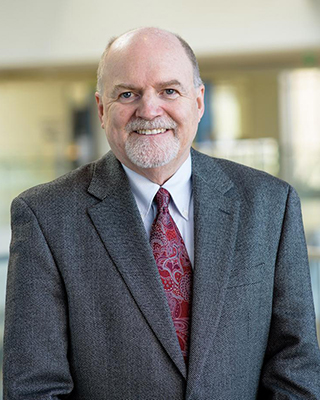
Turcotte holds a doctorate degree in work environment policy and pollution prevention from the University of Massachusetts Lowell.
(Photo courtesy of UMass Lowell)
David Turcotte, Sc.D., helps families and workers reduce environmental health risks in their homes and workplaces. As a public health research professor at the University of Massachusetts (UMass) Lowell and NIEHS-funded principal investigator, he focuses on worker safety, sustainable housing, and innovative approaches to asthma education and intervention.
Turcotte has dedicated his career to community engagement work and mobilizing community partners around environmental health. He began community organizing around public health issues more than 35 years ago when he was president of the local Lowell Fair Share chapter, a grassroots community activism coalition.
“We would knock on doors and tell residents that there was a superfund site nearby and inform them of the potential health risks associated with exposure to harmful chemicals,” Turcotte recalled. “We were raising awareness so that residents could take action to protect their health and safety.”
Engaging Communities to Address Asthma in Massachusetts
Turcotte chairs the steering committee of the Massachusetts Asthma Action Partnership and leads the Healthy Homes Program at UMass Lowell, which works to reduce environmental risks that trigger asthma attacks among low-income seniors and families living in public and subsidized rental housing. According to Turcotte, asthma is an environmental justice issue as it disproportionately affects low-income and minority residents and vulnerable populations like older adults and children.
For more than a decade, he has organized UMass Lowell researchers and community health workers from the Lowell Community Health Center to assess rental housing for asthma triggers such as excess dust, mold and mildew, and pests.
“This program provides low-income families with the education and tools to better manage and improve their indoor environment,” shared Turcotte. “An impact evaluation of the program’s asthma interventions revealed fewer asthma-associated hospital emergency room and doctor visits and showed statistically significant improvements in quality of life and health indicators among hundreds of children in Lowell.”
Turcotte extends the longevity of the program’s effects by conducting training courses with Lowell Housing Authority managers and their maintenance staff on healthy housing practices. As a result, Lowell Housing Authority is a key partner in asthma intervention projects.
“It is important to recognize the value of community organizations and their knowledge and capabilities. My public health research involving community partners would not have been as successful without their contributions,” shared Turcotte. “Researchers should earn a community’s trust and foster a mutually-beneficial partnership that addresses the community’s needs and goals as well as the university’s.”
Promoting Environmental Health and Safety in the Workplace
Turcotte is also the principal investigator of The New England Consortium-Civil Service Employees Association (TNEC-CSEA), a partnership of UMass Lowell; New England coalitions for occupational safety and health (COSH groups) in Massachusetts, Rhode Island, Connecticut, and New Hampshire; and CSEA Local 1000 labor union in New York.
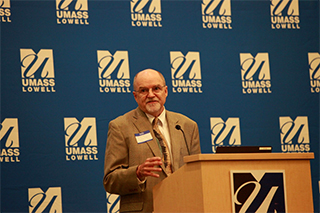
Turcotte spoke at the “Opioids and the Workplace: Prevention and Response,” community stakeholders meeting on July 30, 2019, organized by NIEHS and The New England Consortium at UMass Lowell.
(Photo courtesy of David Turcotte)
Through grant funding from the NIEHS Worker Training Program, TNEC-CSEA delivers health and safety training for workers engaged in hazardous waste cleanup and disaster response and preparedness. On the job, these workers may encounter environmental health hazards such as mold, chemicals, and radiation that could lead to asthma or other health problems. The training empowers workers to protect themselves and surrounding communities from potential disaster and emergency threats while reducing environmental contamination risks. TNEC-CSEA has developed and delivered this training since 1987, reaching about 3,000 workers annually.
“TNEC-CSEA’s partnership infrastructure and CSEA’s peer-to-peer training model allows the program to reach more workers than any of the member organizations could reach alone,” explained Turcotte. “Together, we’re able to use our community networks to reduce occupational health and safety risks, injuries, and negative health consequences, and save more workers’ lives.”
Turcotte shared that sometimes employers have concerns about the costs of providing worker safety and health training and updating workplace practices.
“It’s important to raise awareness among workers, unions, and employers that the return on investment is always greater than the potential costs of not taking action and not understanding occupational health and safety risk mitigating best practices in the workplace,” he said.
Going forward, Turcotte plans to continue to collaborate with community partners to provide worker health and safety training. He is also interested in updating TNEC-CSEA’s curriculum to incorporate new science and potential exposure risks on emerging chemicals and infectious diseases that could be harmful to workers.
Beverly May, Dr.P.H. – Empowering Rural Communities in Central Appalachia
May 28, 2020
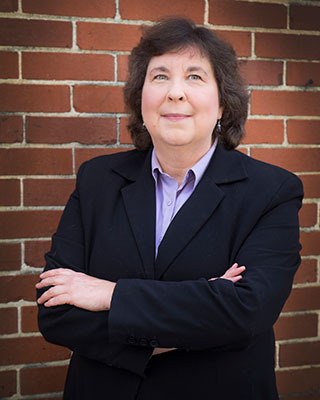
Beverly May, Dr.P.H., strives to empower rural communities to address the environmental issues that concern their health. As a family nurse practitioner in Appalachian Kentucky, May witnessed firsthand the environmental health effects caused by coal mining and natural gas drilling in the region. When her rural valley was slated for mountain top removal, May was inspired to pursue a doctoral degree in public health at the University of Kentucky. Her hollow, a rural valley community, colloquially pronounced “holler,” organized to stop the planned removal, teaching May the value of community voice and participation.
May returned to the hollows in Eastern Kentucky to conduct a community-based participatory study as program manager of the Mountain Air Project (MAP). The project, funded by the NIEHS Research to Action Program, led by co-principal investigators Steven Browning, Ph.D., and Nancy Schoenberg, Ph.D., of the University of Kentucky, aims to reduce respiratory health disparities in Appalachian communities. This Research to Action grantee model has given May the opportunity to blend her expertise as a nurse practitioner working within the community and her skills as a trained epidemiologist evaluating data.
“Epidemiology gave me another layer to work with,” said May. “I am still able to see how the immediate environment affects individuals and families, but also able to take a step back to see the larger environmental exposures. It has given me more tools in the toolbox to understand what we are up against in my community.”
Hollows As Sampling Units
May engaged community members throughout the process, including selecting the project’s name. After identifying respiratory health as their main concern, the research team and community leaders decided to examine the environmental and behavioral factors contributing to the burden of asthma and chronic obstructive pulmonary disease. The second part of the study implements community health interventions based on their findings to improve control measures and reduce hospital visits.
The study focuses on Letcher and Harlan Counties. Residents of these two central Appalachian counties have respiratory health inequities resulting from occupational exposure to coal mine dust, tobacco use, and other harmful exposures. Using the Centers for Disease Control and Prevention Behavioral Risk Factor Surveillance System data, MAP found that nearly a third of adults smoked tobacco and 18.9% suffered from asthma, which is more than double the national average.
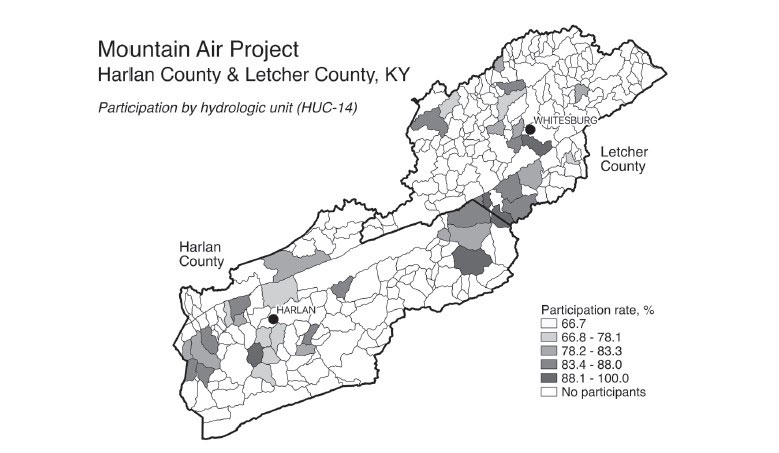
May worked with her research team to explore those statistics further but ran into difficulties determining the correct sampling unit to assess the rural counties. Through community input, May realized the best way to study selected communities was by hollows. Each hollow corresponded to its own river, stream, or lake, also technically identified as a U.S. Geologic Survey 14-digit hydrologic unit code. Community participation made that realization possible.
“Community-based research works well when people are learning from each other,” said May. “Using hollows as a sampling unit is the perfect example. We did not know there was a scientific way to define hollows and the geographer on our team did not know that we define each hollow as a community. We could not have connected the dots alone.”
Community Involvement in Data Collection
To gather information, May and her team extensively trained selected hollow residents to serve as community health workers. They were trained in respiratory health and spirometry, research methodology and ethics, and interviewing approaches. The community health workers then engaged directly with the study participants at their homes, establishing trust throughout the process and reducing barriers to preventative health behaviors, such as smoking cessation.
This community-driven engagement approach led to an 82.1% participation rate of households, which May attributes to the community health workers’ personal connection. Community health workers often had extended family ties or attended the same community centers such as a church.
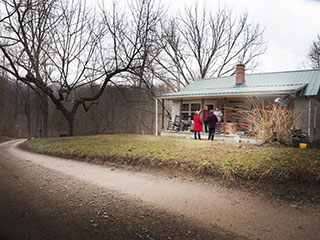
May and MAP community engagement specialist Nell Fields, recruit study participants on Cowan Creek, a hollow in Letcher County.
(Photo courtesy of Tiffany Scott)
“For us, community-based research means that the community experiencing the exposure and who are concerned are working as collaborators with the academic team who want to address the research question,” said May. “We have made it a point to make this project a collaborative effort, which involves sharing power, listening, and accepting guidance throughout the process.”
Research Translated Into Action
The research team has finished collecting household data and is now using those findings to implement the most appropriate interventions. Among their results, they found participants in public housing had twice the risk of asthma, but not those in mobile homes. Additionally, residents who lived in greater proximity of highways showed higher prevalence. These findings led the researchers to test healthy homes interventions to keep homes dry, pest-free, contaminant-free, and more.
May’s leadership in guiding MAP to integrate community-based research is recognized by her alma mater. She is working with a community activist and close friend to develop a training for University of Kentucky researchers on effective community engagement, participatory research, mutual respect, and shared learning.
Dwayne Porter, Ph.D. – Engaging Communities in Water Quality Data and Connection to Quality of Life
May 4, 2020
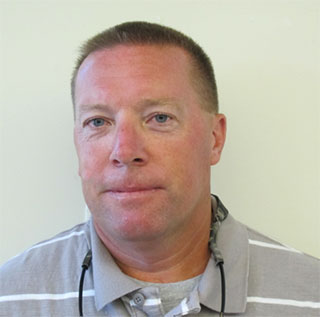
Porter holds a joint administration-faculty appointment with the Department of Environmental Health Sciences and the Baruch Institute for Marine and Coastal Sciences at the University of South Carolina.
(Photo courtesy of Monterey Bay Aquarium Research Institute)
Dwayne Porter, Ph.D., is committed to building collaborative partnerships to break down sector silos and coordinate efforts to advance environmental health research and promote community health. As a professor of environmental health sciences at the University of South Carolina (USC), Porter focuses on translating scientific research into public health benefits, and he stresses the importance of involving the public in decision-making processes.
“My focus is on community-based research and research-based learning to enhance the quality of life for communities,” Porter said. “At USC’s Arnold School of Public Health, our expectation is that our students should not be confined to the classroom and laboratory but should have learning opportunities in the communities of our state and beyond it.”
Addressing Community Concerns Through Research
Porter serves as co-director of the NIEHS-funded USC Center for Oceans and Human Health and Climate Change Interactions (OHHC2I) Community Engagement Core (CEC), where he fosters relationships between academic researchers, policy makers, and the community. The goal of the CEC is to translate results from research on how climate change may affect ocean health, particularly in consideration of harmful algal blooms, microplastics, and the aquatic Vibrio bacteria--all of which may in turn harm human health.
“People living in South Carolina’s coastal communities are concerned about how these growing issues affect their health, from infection resulting from contact with contaminated water, to illness or death from consuming contaminated seafood,” said Porter. “The CEC’s efforts are dedicated to disseminating translated science, resources, and expertise so engaged communities can begin to address environmental health issues.”
To explore further potential health threats and share key findings, Porter and the OHHC2I team have established research collaborations with the National Oceanic and Atmospheric Administration; the United States Geological Survey; the Center for Coastal Environmental and Human Health at the College of Charleston; the University of Maryland Center for Environmental Science; the Interstate Shellfish Sanitation Conference; and the Low Country Alliance for Model Communities. The researchers and graduate students are assessing the health effects of exposure to Vibrio bacteria, cyanobacteria, and microplastics, including specific health problems like non-alcoholic liver disease.
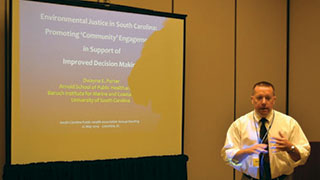
Porter presents at the 2014 South Carolina Public Health Association Annual Meeting.
(Photo courtesy of South Carolina Public Health Association)
Porter uses a variety of techniques and diverse partners to translate scientific findings about environmental health concerns to the affected community and broader public.
“As scientists, we have to be thoughtful in how we are conducting our research and engaging communities,” said Porter. “We have to earn their trust and respect and we have to learn how to listen. Having a close working relationship is important to developing culturally appropriate messages to share information. We want to empower our communities with knowledge they can act on, not alarm them or sensationalize the problem.”
Building Partnerships to Address Water Quality
One of the CEC’s key achievements is addressing the increased occurrences of elevated bacteria levels in the rivers and waterways in South Carolina. Human contact with water containing high concentrations of bacteria can lead to gastrointestinal disorders, respiratory problems, rashes, and other health concerns.
Concerned about people using waterways recreationally, Porter and his team worked with the South Carolina Department of Health and Environmental Control (DHEC) to build a partnership of entities for adopting more cohesive water quality health monitoring practices. The partnership includes wastewater and drinking water utilities, nonprofit organizations, community alliances, industries, local government agencies, and other users of the waters.
“Historically, these groups only sat in the same room if it was a courtroom and they were at odds with each other,” explained Porter. “At the first meeting in 2017, everyone sat in clusters separated by their fields. But we were able to begin dialogue and reach a common realization. Everyone agreed that we wanted the best water quality and the best quality of life for our communities and the people within them.”
The groups went on to form the Lower Saluda River Coalition, which was awarded the DHEC 2017 Community Star Award, an award recognizing collaborative efforts to build community relationships, promote environmental sustainability and resiliency, and improve quality of life for communities. Shortly after receiving the award, the partners expanded their mission to be inclusive of all three Midlands rivers, thus creating the Midlands River Coalition.
Porter and his students also contribute to a citizen-science water-quality monitoring program in which residents collect test samples from South Carolina’s lakes and reservoirs to aid water quality research. They take the results and lead the water quality analysis, then develop educational outreach materials on what neighbors and businesses can do to mitigate harmful algal blooms and how they can make more informed decisions about their use of the waterways. One of the ways that students share their findings is by distributing educational materials and talking with community members and government officials at information booths during community events. Porter and his colleagues are currently exploring the use of this partnership model in other communities.
Unifying the Vision of Environmental Health in South Carolina
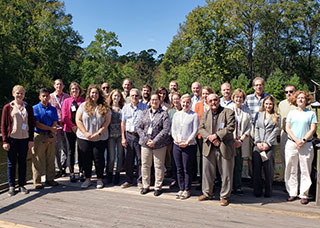
First strategic planning meeting of all Centers for Oceans and Human Health directors and Community Engagement Core leads and partners, held in Georgetown, South Carolina.
(Photo courtesy of Katya Altman)
Porter attributes some of the OHHC2I CEC’s recent success to its work across three National Science Foundation and NIEHS-supported Centers for Oceans and Human Health: the Woods Hole Center for Oceans and Human Health at the Woods Hole Oceanographic Institution; Lake Erie Center for the Great Lakes and Human Health at Bowling Green State University; and the Greater Caribbean Center for Ciguatera Research at Florida Gulf Coast University.
Each center includes a CEC charged with working with communities to identify research needs, engage the communities in research, and support the translation of sound science into useable information to address quality of life issues.
“We’ve realized that if we work collaboratively, taking advantage of the strengths we each bring, we have the opportunity to further advance the quality of life and public health issues across all of the communities within our respective centers,” said Porter.
Moving forward, he aims to continue to collaborate with the CECs to identify and solve environmental health problems for communities in South Carolina and beyond.
Dana Haine – Mixing Research with Creativity to Appeal to Learners
March 12, 2020
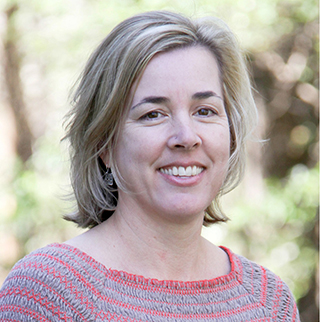
Haine has been working in science education, both in classroom and informal settings, for more than 20 years.
(Photo courtesy of UNC Institute for the Environment)
Dana Haine works with researchers, K-12 teachers, and students to make the newest scientific research digestible for classrooms and communities. As the K-12 science education manager for the Center for Public Engagement with Science within the University of North Carolina Institute for the Environment, she delivers new and relevant environmental health research findings, such as the health effects of e-cigarettes and implications of climate change, to learners.
Her interest in science goes back to childhood, but it was while working toward a master’s degree in biology that she decided to pursue a career outside a laboratory. Following graduation, she began teaching biology at Central Piedmont Community College in Charlotte, North Carolina. Her classes consisted mostly of non-majors, which inspired her to make the course content as relevant and engaging as possible.
“I knew that for many of my students, my biology course might be the only one they would ever take,” Haine said. “To make the course relevant and useful, I incorporated human health topics as much as possible. When we talked about the cell cycle, we talked about cancer. When we talked about the brain, we talked about the effects of drugs and alcohol on the nervous system.”
Bringing New Research into Classrooms and Communities
Today, Haine works within the Community Engagement Core (CEC) in the UNC Center for Environmental Health and Susceptibility (CEHS), an NIEHS Environmental Health Science Core Center, to bring engaging environmental health science content to K-12 students and other learners.
Haine explained that she often sees a disconnect between K-12 curriculum standards and current research. This presents a challenge for science-minded students graduating from high school, as they may not be aware of the current scientific research and all of the opportunities available to them as undergraduate students.
As she became familiar with the work of CEHS scientists, Haine saw an opportunity to integrate their timely, cutting-edge research findings into learning modules for students.
“By connecting teachers with current research findings through development of classroom-ready activities, we play a valuable role not only in preparing the next generation of scientists but also in promoting their understanding of environmental health topics,” Haine said.
Haine’s work with CEHS has also involved creating lessons for members of the wider community such as public health professionals. In 2016, Haine collaborated with John Balbus, M.D., NIEHS senior advisor for public health, to update an interactive lesson plan about climate change and human health. The lesson has since been adapted for use with clinical and public health students and practitioners. Most recently, Haine developed an online training module for public health professionals titled Extreme Heat & Air Quality: Implications for Human Health that will be released this spring.
Bringing the Science of E-cigarettes to K-12 Students
Haine found relevant, timely material for one of her latest projects by listening to a talk on the health effects of e-cigarette liquids and aerosols, given by Ilona Jaspers, Ph.D., research director for cardiopulmonary disease at CEHS.
“She was a very dynamic and engaging speaker, and she was passionate about taking her research to K-12 audiences,” Haine said. “She talked about how teenagers start to vape because of the appealing flavors but often have no idea those flavors contain addictive nicotine and that the flavors themselves may be harmful.”
Haine teamed up with Jaspers, connecting the researcher with middle and high schools for speaking engagements. At these events, Haine paid attention to questions raised by students and teachers. This exploratory process revealed young people’s misconceptions about vaping and guided Haine in the creation of a high school lesson on the topic.
To create the lesson, Haine turned to Jasper’s recent research papers and to Elise Hickman, one of Jasper’s doctoral students. Together, they created a two-part lesson plan, in which students examine experimental data showing how e-cigarette flavorings affect immune cells and how cinnamaldehyde, a flavoring, impacts cilia movement in the lungs by impairing mitochondrial function.
The lesson was piloted in three classrooms, two in North Carolina and one in Texas, in spring 2019. After some fine-tuning, Haine and Hickman modeled the lesson for teachers attending the North Carolina Science Teachers Association and the National Association of Biology Teachers annual meetings.
“One thing I really enjoy doing with my work, especially federally funded work, is disseminating it to teachers beyond North Carolina,” Haine said. “Conference presentations are a great avenue for disseminating lessons, especially national conferences because they often attract K-12, community college, and four-year college faculty.”
Engaging with Students Outside the Classroom
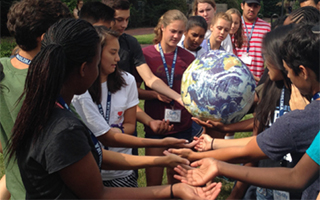
Students participating in Climate LEAP, hosted by the UNC Institute for the Environment.
(Photo courtesy of UNC Institute for the Environment)
Haine also designs and delivers extracurricular STEM learning opportunities to students outside the classroom. From 2009-2017, she led the Climate Leadership and Energy Awareness (Climate LEAP), a year-long STEM program, where students learn about changing weather patterns and how human health may be affected.
In 2017, with supplemental funding from NIEHS, the UNC CEHS partnered with Columbia University’s Environmental Health Science Core Center and its community partner WE ACT to collaborate on informal youth programming that ultimately enabled Haine to introduce Climate LEAP participants to new topics such as climate resilience and climate justice.
“I’m working to create a better planet for our children,” Haine said. “The more I’ve learned as a result of my work, the more aware I’ve become of how the environment impacts our health, and I want to help people understand that connection.”
Haine looks forward to continuing her work with the NIEHS-funded CEHS, where she is able to approach research translation, lesson development, and outreach efforts with freedom and creativity.
Laurel Schaider, Ph.D. – On the Frontlines of PFAS Research
February 3, 2020
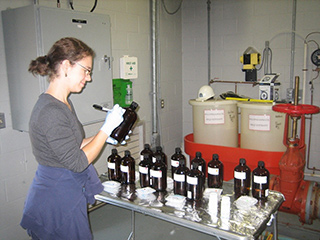
Laurel Schaider led a study of pharmaceuticals, consumer product chemicals, and endocrine disruptors in Cape Cod public drinking water supplies. Silent Spring Institute first found PFAS in Cape Cod drinking water in 2010.
(Photo courtesy of Laurel Schaider)
When Laurel Schaider, Ph.D., joined Silent Spring Institute in 2009, she began studying contaminants of emerging concern in public and private drinking water wells on Cape Cod. The region’s porous sandy soils allow surface pollutants to easily percolate through the ground, seep into wells, and contaminate drinking water. Silent Spring scientists wanted to know if pharmaceuticals and other chemicals from consumer products were making their way into well water. Among the chemicals they found were per- and polyfluoroalkyl substances (PFAS), a complex class of manufactured chemicals. Since then, Schaider has focused her research on how PFAS move through the environment, how people can be exposed, and how they affect human health.
Widespread PFAS Contamination
In use since the 1950s, PFAS are found in many consumer products, from cosmetics and dental floss to tents and non-stick frying pans. They are known as “forever chemicals” because they do not break down in the environment. Exposure to PFAS is linked to a wide range of potential health effects, such as thyroid disease, high cholesterol, liver damage, low birth weight, decreased effectiveness of vaccines, and some types of cancer.
Because of these health concerns, EPA required large public water supplies in the U.S. to test for PFAS from 2013 to 2015. The testing showed that 6 million Americans were being served by public water supplies where PFAS exceeded EPA’s guideline. “That really got a lot of people’s attention,” said Schaider.
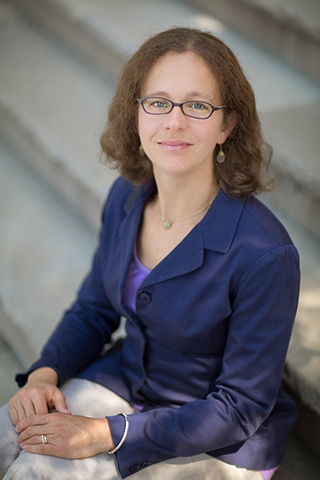
Laurel Schaider and her team released a new research paper in October 2019 on how food packaging could affect population exposure to PFAS.
(Photo courtesy of Laurel Schaider)
That 6 million figure was just the tip of the iceberg; current estimates put the number of Americans with PFAS in their drinking water at more than 100 million. People can be exposed to PFAS from other sources, such as crops grown in PFAS-contaminated soil; grease-resistant food wrappers, pizza boxes, and microwave popcorn bags; and stain-resistant carpeting.
As the lead investigator of Silent Spring’s PFAS-REACH (Research, Education, and Action for Community Health) project and the Community Engagement Core co-leader for the University of Rhode Island’s STEEP Superfund Research Program, Schaider has become a nationally recognized expert on PFAS.
Schaider and her team have studied the prevalence of PFAS chemicals in fast food packaging and the effects of dietary habits on PFAS exposures. For example, her research has found that people who eat more meals at home as opposed to eating out have lower levels of PFAS in their body, and people who eat more microwave popcorn have significantly higher PFAS levels. These results suggest that food packaging is an important source of exposure to PFAS.
Community-Engaged Research
As part of her work at Silent Spring, Schaider communicates PFAS research findings to communities involved in the studies.
“Part of our mission is to translate what we learn to improve people’s health and reduce their risk of disease,” said Schaider. “We provide information to consumers on how to reduce their exposure to potentially harmful chemicals in their daily lives.”
Schaider does much of her research in partnership with community groups, including the Massachusetts Breast Cancer Coalition, Testing for Pease, and Toxics Action Center. She first conducted research in a community setting when she was a postdoctoral fellow at the Harvard T.H. Chan School of Public Health as part of an NIEHS-funded project at the Tar Creek Superfund Site in northeastern Oklahoma. She studied the environmental trail of contaminant metals like zinc, lead, and cadmium in the Tar Creek community.
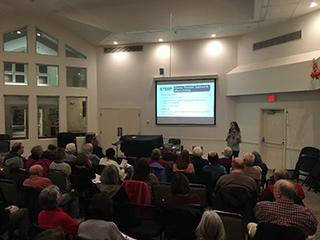
Laurel Schaider, November 2019, shared preliminary findings from the STEEP Superfund Research Program’s study of PFAS chemicals in Cape Cod private wells at the Unitarian Universalist Fellowship of Falmouth.
(Photo courtesy of Laurel Schaider)
The goal was to detect and characterize the presence of heavy metals from mine waste in Tar Creek and to examine how the metals migrated into neighboring yards and homes. Project leaders worked with a community organization, the LEAD (Local Environmental Action Demanded) Agency, to develop a study and conduct the research. This included measuring levels of exposure in the community and evaluating the effects of contamination on community health.
During this period, Schaider also led a project investigating mercury exposure from eating fish caught in Grand Lake, which is downstream of Tar Creek. This project also involved significant community participation. Local fishermen and the Oklahoma Department of Wildlife Conservation provided the catch used for mercury analysis, residents of the Grand Lake area completed questionnaires about their fish consumption, and community advisors aided in study design and implementation.
“Community members have so much knowledge,” said Schaider. “It’s essential, especially for environmental public health research, to make sure we are capturing that knowledge and asking questions that community members really want answered so they can improve their health.”
Looking forward, Schaider is excited to start collaborating with the Agency for Toxic Substances and Disease Registry (ATSDR) on a multi-site PFAS health study. The federal study is investigating communities across the country that have experienced PFAS contamination in their drinking water supply. Leading one of seven projects funded through the ATSDR study, Silent Spring researchers will be testing children and adults for a range of known PFAS chemicals and correlating PFAS exposures with different biological markers of health effects. The team will also be collecting new information about previously unidentified PFAS chemicals to which communities may have been exposed.


